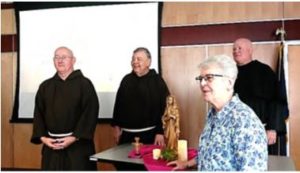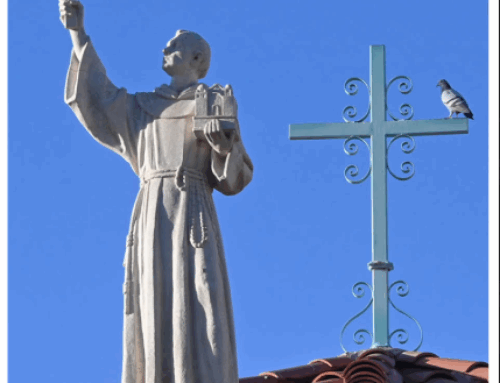(This article originally appeared in the Summer/Fall 2019 issue of TAU-USA)
Secular Franciscans Explore “Clare of God: A Spirituality for our Time”
Summer Seminar recap by Anna Rzewnicki, SFO, Padre Pio Fraternity, Raleigh, N.C.
 “Sometimes, we are drawn to something because it’s already in us,” said Sr. Loretta Schaff, OSF, D. Min., in her opening remarks at the 10th Annual Summer Seminar for Secular Franciscans, held July 11-14, 2019, at St. Francis University in Loretto, Penn. “We try to reach that something – heart to soul and back again,” she said.
“Sometimes, we are drawn to something because it’s already in us,” said Sr. Loretta Schaff, OSF, D. Min., in her opening remarks at the 10th Annual Summer Seminar for Secular Franciscans, held July 11-14, 2019, at St. Francis University in Loretto, Penn. “We try to reach that something – heart to soul and back again,” she said.
Sharing insights from her reflections on St. Clare of Assisi (1194-1253), a contemporary of St. Francis of Assisi and founder of the Poor Ladies or Poor Clares, Sr. Loretta said she had a sense that Clare would have phrased it this way: “You are to be who you are, as I was who I was.”
Sr. Loretta, a sister of St. Francis of Philadelphia, musician, educator and regional spiritual assistant for the Troubadours of Peace Region in the Pacific Northwest, and Fr. John Petrikovic, OFM Cap., now a full-time preacher, Franciscan researcher and musician on the staff of the Assisi Franciscan pilgrimages Program, co-led the seminar, incorporating music, art and liturgy to present the life and legacy of St. Clare and her relevance for our times.
The Very Rev. Joseph Lehman, TOR, Minister, Province of the Most Sacred Heart of Jesus, was spiritual assistant, and Br. Robert Herrick, OFM Cap., was music minister.
Learning more about St. Clare, her environment, abandonment of the wealth of her family and embracing Christ’s riches – his poverty – were among key takeaways for the 50-plus attendees, who represented 22 fraternities in 11 states from Delaware to Arizona.
The presenters provided historical context, explaining that, like Francis, Clare and her two sisters – Catherine (later taking the name Agnes) and Beatrice – grew up as members of Assisi’s noble class in the feudal world of 13th century Italy. Theirs was an era of romanticism and rules of courtly life, including marriage and managing a household of their own.
They were guided by their mother Ortolana – a pious woman who was a poet and who had made several pilgrimages to Monte Gargano and Rome, as well as a hazardous journey to the Holy Land.
Theirs was also a turbulent era. From the age of six to 12, Clare, with her mother, sister and servants, lived in exile in Perugia until a treaty with the citizens of Assisi was settled in 1205.
When Clare was 17, she heard Francis preach. Her “heart was set on fire,” and she received radical grace, Sr. Loretta said. On Palm Sunday 1212, Clare left her family home and a life of nobility to join Francis, cutting her hair and donning a poor tunic, as Francis and the brothers had. He brought her to a Benedictine monastery in nearby Bastia; later, her sister Catherine (Agnes) joined her there.
Their uncle Monaldo, now the family patriarch, angry about losing two daughters of the family who could enrich their noble status through marriage, accompanied by armed kinsmen, went to the monastery to bring Clare, and later Catherine, home; both successfully resisted.
Clare later moved to a residence with a women’s community at Sant’Angelo in Panzo until Francis and the brothers could ready her new home at San Damiano – where St. Francis heard his call to rebuild the Church. They were joined by other women, including her mother after her husband’s death.
Clare wrote a Form of Life for her community, which had grown to more than 50 women, and reluctantly accepted the title of abbess, although she preferred to serve as guardian. She provided a formula for the Poor Clares – gaze, consider, contemplate, so as to imitate – and held to a strict regimen: she fasted, went barefooted, sewed, and slept on a straw mat.
Clare’s influence reached beyond her immediate community, as documented by four letters she wrote to Agnes of Prague, the daughter of the king of Bohemia (1234-1253),who sought to follow Clare’s vision of poverty in following Christ Jesus. “What Clare said to Agnes is also meant for us,” Sr. Loretta said.
In the four letters, Clare commends Agnes for selecting poverty; appears to provide spiritual direction; encourages her to be a co-worker with God, to become what she is reflecting on in the San Damiano cross; and encourages her to carryon living the Form of Life, saying, “Gaze upon that mirror each day and study your face in it. That reflection becomes a reflection to others.”
Fr. John discussed Clare’s efforts to receive approval from the Pope for the Poor Ladies’ life of poverty. Like Francis, she wanted her sisters to live as “pilgrims and strangers in this world,” allowing God to be God. Her “privilege of poverty” was to not accept lands and resources which secured life for the sisters, like the other monasteries of Europe. Clare did not want to be forced to be “secure.” She trusted God would provide.
Clare died at age 60, the day after approval for her Form of Life was granted by the Pope. She was canonized just two years later, in 1255.
Fr. John said, “Seeing St. Clare’s life in the context of the 13th century allows us to see that we are not called to pretend or to ‘imitate’ the details of what she did, but to respond to grace within our own contexts and lives.”
He provided as example the Dossal of St. Clare, a painting from c. 1280 depicting events in her life, saying that “each of us could create a dossal of our own lives, to detail how God is working in and through our humanity.”
Fr. John also discussed how Clare’s and Francis’ vision of an apostolic life had evolved through their century’s understanding that Jesus’ life was one of itinerancy. He had asked his disciples to “follow me;” their experiences on the road would teach them to respond to the Lord’s invitation to exercise love in the real faces of those they encountered on the journey.
About fraternity, Sr. Loretta said, “That is the place where we can engage in deeper conversations. Find someone that you can talk with deeply about your relationship with Christ. Clare and Agnes were doing this, but it’s so much bigger than the two of them. It’s beyond Assisi; it’s worldwide.”
“Francis responded to the Spirit through the eyes of a merchant and future knight; Clare, through the eyes of a noble lady and bride,” Fr. John said. “Our changing times will give shape to that same Spirit. Through contemplation and reflection on the mirror of Christ’s immense love and charity, will we be able to incarnate that immense love in a language which we can speak today? Can we allow the clear light of God’s mercy and peace to shine in the 21st century,” he asked, “so that people can hear and be drawn to the Gospel in our time and space? It’s truly a spirituality, not for the dust of history, but for our time.”


Leave A Comment